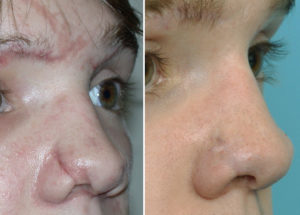Scars are by far and away the concern of most plastic surgery patients, either before or after surgery. They are keenly interested in how to diminish their appearance and or what specific preventative or treatment strategies would be most effective. Scars can also be a source of tremendous dissatisfaction if they become exaggerated due to poor healing or inadvertent misplacement for their ideal location when seen after surgery.
There are many variables that affect how well a scar heals and its subsequent appearance. All other factors beinjg equal, the most signfiicant one is skin color or the degree of natural pigmentation. The more pigment that is in the skin (thicker dermis) the higher the risk is for more reactive scarring appearing as hypertrophic or wide scarring and potentially even keloids. At the least, darker skin will almost always hyperpigment, and sometimes even hypopigment, even if the scar line is very narrow. One of the best indicators of how well any patient will scar is to look ar their previous scars, particularly those created by surgery. But don’t confuse how a traumatic leg scar looks with what their facelift scars will do. Location of scars is almost as important as skin pigmentation and thickness.
The single most effective method to minimize scars is what the plastic surgeon does…careful placement and a meticulous layered wound closure. Plastic surgery often takes longer because more attentioin is paid to getting the scar closed as well as possible. One of the great misconceptions is that the use of a laser to make an incision will result in a better scar. It makes for better marketing but not better scars. Lasers, as opposed to the cold steel of a scalpel blade, always increases the risk of adverse pigment changes due to its heat…and they also cause delayed wound healing .

While patients can’t wait to see how their scars look after the dressings or tapes are removed, the initial appearance of a scar is just the beginning of a cycle. All scars go through a life cycle of healing and then maturation which is different for various body locations and procedures. In general, scars will usually look worse before they get better.
Dr. Barry Eppley
Indianapolis, Indiana


